International Journal of Intelligent Systems and Applications @ijisa
Статьи журнала - International Journal of Intelligent Systems and Applications
Все статьи: 1203
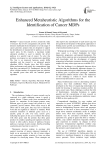
Enhanced Metaheuristic Algorithms for the Identification of Cancer MDPs
Статья научная
Cancer research revolves around the study of diseases that involve unregulated cell growth. This direction facilitated the development of a wide range of cancer genomics projects that are designed to support the identification of mutated driver pathways in several cancer types. In this research, a maximum weight submatrix problem is used to identify the driver pathway in a specific type of cancer. To solve this problem, we propose two new metaheuristic algorithms. The first is an improved harmony search (IHS) algorithm and the second is an enhanced genetic algorithm (EGA). Results show that EGA enables better performance and entails less computational time than does conventional GA. Furthermore, the new IHS offers a higher number of suggested gene set solutions for mutated genes than does the standard genetic algorithm.
Бесплатно
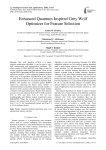
Enhanced Quantum Inspired Grey Wolf Optimizer for Feature Selection
Статья научная
Grey wolf optimizer (GWO) is a nature inspired optimization algorithm. It can be used to solve both minimization and maximization problems. The binary version of GWO (BGWO) uses binary values for wolves’ positions rather than probabilistic values in the original GWO. Integrating BGWO with quantum inspired operations produce a novel enhanced quantum inspired binary grey wolf algorithm (EQI-BGWO). In this paper we used feature selection as an optimization problem to evaluate the performance of our proposed algorithm EQI-BGWO. Our method was evaluated against BGWO method by comparing the fitness value, number of eliminated features and global optima iteration number. it showed a better accuracy and eliminates higher number of features with good performance. Results show that the average error rate enhanced from 0.09 to 0.06 and from 0.53 to 0.52 and from 0.26 to 0.23 for zoo, Lymphography and diabetes dataset respectively using EQI-BGWO, Where the average number of eliminated features was reduced from 6.6 to 6.7 for zoo dataset and from 7.3 to 7.1 for Lymphography dataset and from 2.9 to 3.2 for diabetes dataset.
Бесплатно
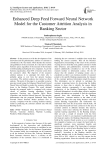
Статья научная
In the present era with the development of the innovation and the globalization, attrition of customer is considered as the vital metric which decides the incomes and gainfulness of the association. It is relevant for all the business spaces regardless of the measure of the business notwithstanding including the new companies. As per the business organization, about 65% of income comes from the customer's client. The objective of the customer attrition analysis is to anticipate the client who is probably going to exit from the present business association. The attrition analysis also termed as churn analysis. The point of this paper is to assemble a precise prescient model using the Enhanced Deep Feed Forward Neural Network Model to predict the customer whittling down in the Banking Domain. The result obtained through the proposed model is compared with various classes of machine learning algorithms Logistic regression, Decision tree, Gaussian Naïve Bayes Algorithm, and Artificial Neural Network. The outcome demonstrates that the proposed Enhanced Deep Feed Forward Neural Network Model performs best in accuracy compared with the existing machine learning model in predicting the customer attrition rate with the Banking Sector.
Бесплатно
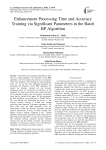
Статья научная
The batch back prorogation algorithm is anew style for weight updating. The drawback of the BBP algorithm is its slow learning rate and easy convergence to the local minimum. The learning rate and momentum factor are the are the most significant parameter for increasing the efficiency of the BBP algorithm. We created the dynamic learning rate and dynamic momentum factor for increasing the efficiency of the algorithm. We used several data set for testing the effects of the dynamic learning rate and dynamic momentum factor that we created in this paper. All the experiments for both algorithms were performed on Matlab 2016 a. The stop training was determined ten power -5. The average accuracy training is 0.9909 and average processing time improved of dynamic algorithm is 430 times faster than the BBP algorithm. From the experimental results, the dynamic algorithm provides superior performance in terms of faster training with highest accuracy training compared to the manual algorithm. The dynamic parameters which created in this paper helped the algorithm to escape the local minimum and eliminate training saturation, thereby reducing training time and the number of epochs. The dynamic algorithm was achieving a superior level of performance compared with existing works (latest studies).
Бесплатно
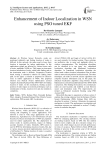
Enhancement of Indoor Localization in WSN using PSO tuned EKF
Статья научная
In Wireless Sensor Networks, nodes are positioned arbitrarily and finding location of nodes is difficult. In this network, the nodes need to know their location is important for indoor applications. In this applications signals are affected by various factors such as noise, multipath, NLOS etc. This impact on inaccurate location information of node, which leads finding path to the destination node is difficult. Cooperative location based routing is alternative solution for finding better path. In this paper a solution is proposed for effective route in indoor application of WSN. The proposed solution uses Particle Swarm Optimization assisted Adaptive Extended Kalman Filter (PSO-AKF) for finding location of nodes. In this mechanism, finding accurate position of node impact on network performance such as minimization of delay, location error and also minimizes complexity.
Бесплатно
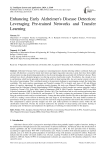
Enhancing Early Alzheimer's Disease Detection: Leveraging Pre-trained Networks and Transfer Learning
Статья научная
Alzheimer's Disease (AD) is a progressive neurodegenerative disorder affecting millions worldwide. Early and accurate AD detection is crucial for timely intervention and improving patient outcomes. Lately, there have been notable advancements in using deep learning approaches to classify neuroimaging data associated with Alzheimer's disease. These methods have shown substantial progress in achieving accurate classification results. Nevertheless, the concept of end-to-end learning, which has the potential to harness the benefits of deep learning fully, has yet to garner extensive focus in the realm of neuroimaging. This is attributed mainly to the persistent challenge in neuroimaging, namely the limited data availability. This study employs neuroimages and Transfer Learning (TL) to identify early signs of AD and different phases of cognitive impairment. By employing transfer learning, the study uses Magnetic Resonance Imaging (MRI) images from the Alzheimer's Disease Neuroimaging (ADNI) database to classify images into various categories, such as Cognitively Normal (CN), Early Mild Cognitive Impairment (EMCI), Mild Cognitive Impairment (MCI), Late Mild Cognitive Impairment (LMCI), and Alzheimer's Disease (AD). The classification task involves training and testing three pre-trained networks: VGG-19, ResNet-50, and Inception V3. The study evaluates the performance of these networks using the confusion matrix and its associated metrics. Among the three models, ResNet-50 achieves the highest recall rate of 99.25%, making it more efficient in detecting the early stages of AD development. The study further examines the performance of the pre-trained networks on a class-by-class basis using the parameters derived from the confusion matrix. This comprehensive analysis provides insights into how each model performs for different classes within the AD classification framework. Overall, the research underscores the potential of deep learning and transfer learning in advancing early AD detection and emphasizes the significance of utilizing pre-trained models for this purpose.
Бесплатно
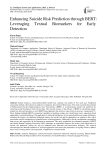
Enhancing Suicide Risk Prediction through BERT: Leveraging Textual Biomarkers for Early Detection
Статья научная
Suicide remains a critical global public health issue, claiming vast number of lives each year. Traditional assessment methods, often reliant on subjective evaluations, have limited effectiveness. This study examines the potential of Bidirectional Encoder Representations from Transformers (BERT) in revolutionizing suicide risk prediction by extracting textual biomarkers from relevant data. The research focuses on the efficacy of BERT in classifying suicide-related text data and introduces a novel BERT-based approach that achieves state-of-the-art accuracy, surpassing 97%. These findings highlight BERT's exceptional capability in handling complex text classification tasks, suggesting broad applicability in mental healthcare. The application of Artificial Intelligence (AI) in mental health poses unique challenges, including the absence of established biological markers for suicide risk and the dependence on subjective data, which necessitates careful consideration of potential biases in training datasets. Additionally, ethical considerations surrounding data privacy and responsible AI development are paramount. This study emphasizes the substantial potential of BERT and similar Natural Language Processing (NLP) techniques to significantly improve the accuracy and effectiveness of suicide risk prediction, paving the way for enhanced early detection and intervention strategies. The research acknowledges the inherent limitations of AI-based approaches and stresses the importance of ongoing efforts to address these issues, ensuring ethical and responsible AI application in mental health.
Бесплатно
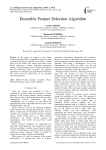
Ensemble feature selection algorithm
Статья научная
In this paper, we propose a new feature selection algorithm based on ensemble selection. In order to generate the library of models, each model is trained using just one feature. This means each model in the library represents a feature. Ensemble construction returns a well performing subset of features associated to the well performing subset of models. Our proposed approaches are evaluated using eight benchmark datasets. The results show the effectiveness of our ensemble selection approaches.
Бесплатно
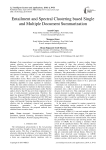
Entailment and spectral clustering based single and multiple document summarization
Статья научная
Text connectedness is an important feature for content selection in text summarization methods. Recently, Textual Entailment (TE) has been successfully employed to measure sentence connectedness in order to determine sentence salience in single document text summarization. In literature, Analog Textual Entailment and Spectral Clustering (ATESC) is one such method which has used TE to compute inter-sentence connectedness scores. These scores are used to compute salience of sentences and are further utilized by Spectral Clustering algorithm to create segments of sentences. Finally, the most salient sentences are extracted from the most salient segments for inclusion in the final summary. The method has shown good performance earlier. But the authors observe that TE has never been employed for the task of multi-document summarization. Therefore, this paper has proposed ATESC based new methods for the same task. The experiments conducted on DUC 2003 and 2004 datasets reveal that the notion of Textual Entailment along with Spectral Clustering algorithm proves to be an effective duo for redundancy removal and generating informative summaries in multi-document summarization. Moreover, the proposed methods have exhibited faster execution times.
Бесплатно
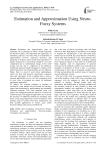
Estimation and Approximation Using Neuro-Fuzzy Systems
Статья научная
Estimation and Approximation plays an important role in planning for future. People especially the business leaders, who understand the significance of estimation, practice it very often. The act of estimation or approximation involves analyzing historical data pertaining to domain, current trends and expectations of people connected to it. Exercising estimation is not only complicated due to technological change in the world around, but also due to complexity of the problems. Traditional numerical based techniques for solution of ill-defined non-linear real world problems are not sufficient. Hence, there is a need of some robust methodologies which can deal with dynamic environment, imprecise facts and uncertainty in the available data to achieve practical applicability at low cost. Soft computing seeks to solve class of problems not suited for traditional algorithmic approaches. To address the common problems in business of inexactness, some models are put forward for servicing, support and monitoring by approximating and estimating important outcomes. This work illustrates some very general yet widespread problems which are of interest to common people. The suggested approaches can overcome the fuzziness in traditional methods by predicting some future events and getting better control on business. This includes study of various neuro-fuzzy architectures and their possible applications in various areas, where decision-making using classical methods fail.
Бесплатно
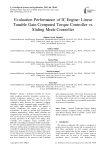
Статья научная
Design a nonlinear controller for second order nonlinear uncertain dynamical systems (e.g., internal combustion engine) is one of the most important challenging works. This paper focuses on the comparative study between two important nonlinear controllers namely; computed torque controller (CTC) and sliding mode controller (SMC) and applied to internal combustion (IC) engine in presence of uncertainties. In order to provide high performance nonlinear methodology, sliding mode controller and computed torque controller are selected. Pure SMC and CTC can be used to control of partly known nonlinear dynamic parameters of IC engine. Pure sliding mode controller and computed torque controller have difficulty in handling unstructured model uncertainties. To solve this problem applied linear error-based tuning method to sliding mode controller and computed torque controller for adjusting the sliding surface gain (λ ) and linear inner loop gain (K). Since the sliding surface gain (λ) and linear inner loop gain (K) are adjusted by linear error-based tuning method. In this research new λ and new K are obtained by the previous λ and K multiple gains updating factor(α). The results demonstrate that the error-based linear SMC and CTC are model-based controllers which works well in certain and uncertain system. These controllers have acceptable performance in presence of uncertainty.
Бесплатно
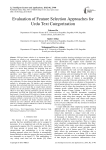
Evaluation of Feature Selection Approaches for Urdu Text Categorization
Статья научная
Efficient feature selection is an important phase of designing an effective text categorization system. Various feature selection methods have been proposed for selecting dissimilar feature sets. It is often essential to evaluate that which method is more effective for a given task and what size of feature set is an effective model selection choice. Aim of this paper is to answer these questions for designing Urdu text categorization system. Five widely used feature selection methods were examined using six well-known classification algorithms: naive Bays (NB), k-nearest neighbor (KNN), support vector machines (SVM) with linear, polynomial and radial basis kernels and decision tree (i.e. J48). The study was conducted over two test collections: EMILLE collection and a naive collection. We have observed that three feature selection methods i.e. information gain, Chi statistics, and symmetrical uncertain, have performed uniformly in most of the cases if not all. Moreover, we have found that no single feature selection method is best for all classifiers. While gain ratio out-performed others for naive Bays and J48, information gain has shown top performance for KNN and SVM with polynomial and radial basis kernels. Overall, linear SVM with any of feature selection methods including information gain, Chi statistics or symmetric uncertain methods is turned-out to be first choice across other combinations of classifiers and feature selection methods on moderate size naive collection. On the other hand, naive Bays with any of feature selection method have shown its advantage for a small sized EMILLE corpus.
Бесплатно
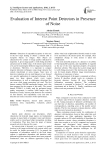
Evaluation of Interest Point Detectors in Presence of Noise
Статья научная
Detection of repeatable keypoints is often one of the first steps leading to obtain a solution able to recognise objects on images. Such objects are characterised by content of image patches indicated by keypoints. A given image patch is worth being described and processed in further steps, if the interest point inside of it can be found despite different image transformations or distortions. Therefore, it is important to compare keypoint detection techniques using image datasets that contain transformed or noisy images. Since most of detector evaluations rely on small datasets or are focused on a specific application of compared techniques, in this paper two large datasets which cover typical transformations, as well as challenging distortions that can occur while image processing, are used. The first dataset contains 200,000 transformed images, and it has been prepared for the purpose of this study. The second dataset, TID2013, is widely used for perceptual image quality assessment; it contains 3,000 images with 24 distortions. Finally, interest point detectors are evaluated on four datasets, and repeatability score and time of detection are used as measures of their performance.
Бесплатно
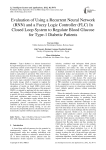
Статья научная
Type-1 diabetes is a disease characterized by high blood-glucose level. Using a fully automated closed loop control system improves the quality of life for type1 diabetic patients. In this paper, a scalable closed loop blood glucose regulation system which is tuned to each patient is presented. This control system doesn't need any data entry from the patient. A recurrent neural network (RNN) is used as a nonlinear predictor and a fuzzy logic controller (FLC) is used to determine the insulin dosage which is required to regulate the blood glucose level. The insulin infusion is restricted by calculation of insulin on board (IOB) which avoids overdosing of insulin. The performance of the proposed NMPC is evaluated by applying full day meal regime to each patient. The evaluation includes testing in relation to specific life style condition, i.e. fasting, postprandial, fault meal estimation, and exercise as a metabolic disturbance. Our simulation results indicate that, the use of a RNN along with a FLC can decrease the postprandial glucose concentration. The proposed controller can be used in fasting and can avoid severe hypo or hyper-glycemia during fasting. It can also decrease the postprandial glucose concentration and can dynamically respond to different glycemic challenges.
Бесплатно
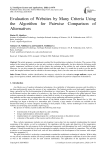
Evaluation of Websites by Many Criteria Using the Algorithm for Pairwise Comparison of Alternatives
Статья научная
The article proposes a comprehensive method for the multicriteria evaluation of websites. The essence of this method is that using this method we can not only evaluate a website traditionally, but also obtain the following useful results: importance coefficient of each of the criteria, the evaluation of the website for each criterion individually. Moreover, we can also compare the sampled websites and then rank them. It is noted that in order to get the precise result, the sampled websites must be referred to the same category, that is, have the same set of criteria for evaluation.
Бесплатно
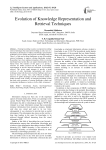
Evolution of Knowledge Representation and Retrieval Techniques
Статья научная
Existing knowledge systems incorporate knowledge retrieval techniques that represent knowledge as rules, facts or a hierarchical classification of objects. Knowledge representation techniques govern validity and precision of knowledge retrieved. There is a vital need to bring intelligence as part of knowledge retrieval techniques to improve existing knowledge systems. Researchers have been putting tremendous efforts to develop knowledge-based system that can support functionalities of the human brain. The intention of this paper is to provide a reference for further research into the field of knowledge representation to provide improved techniques for knowledge retrieval. This review paper attempts to provide a broad overview of early knowledge representation and retrieval techniques along with discussion on prime challenges and issues faced by those systems. Also, state-of-the-art technique is discussed to gather advantages and the constraints leading to further research work. Finally, an emerging knowledge system that deals with constraints of existing knowledge systems and incorporates intelligence at nodes, as well as links, is proposed.
Бесплатно
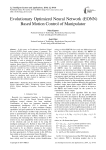
Evolutionary Optimized Neural Network (EONN) Based Motion Control of Manipulator
Статья научная
In this paper, an Evolutionary Optimized Neural Network (EONN) based control scheme is proposed. This control scheme is based on the fact that optimizing values of a few parameters of neural network can enhance its control performance. Radial Biased Neural Network (RBNN) is chosen here and PSO, one of the most emerging global optimizing techniques, is used to optimize the parameters of a RBNN. From hidden to output layer RBNN uses Gaussian function for mapping. Spread factor (s) of this intelligent RBNN is then optimized by a modified PSO to improvise its performance. The proposed controller has been verified by implementing it for position control of a robotic manipulator. For comparison purpose, proposed scheme has been verified with RBNN and the classical PD controller. MATLAB environment has been chosen for simulation study carried out. Robustness of the proposed controller has been checked by applying it to the manipulator for three different paths.
Бесплатно
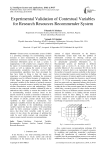
Experimental validation of contextual variables for research resources recommender system
Статья научная
Context-aware recommender system (CARS) is a promising technique for recommending research resources to users (researchers) by predicting their preferences (resources) under different situations. If the contextual information given to such a system is inappropriate, it will certainly have a negative effect on the nature of recommendation output generated by the system as well as making the system to have high dimensionality complexity. Currently, several CARS recommendation algorithms have been developed but they have failed to bring to bear the means and importance of experimentally validating the contextual information used in different domains of application of CARS. Hence, this paper experimentally validates the contextual variables in the domain of research resources by splitting a research resource (article) into three major sections (introduction, review and methodology). These sections are the contextual variables validated in order to authenticate their viability as context that could be used in recommending research resources based on the specific section of an article a researcher is interested in. The result of our experiment shows that irrespective of the domain of articles, journal articles have higher variability in their citations at introduction, very significant variability between the articles in the review and high variability in the methodology contextual variable respectively than the articles in the proceeding under the three contextual variables. This experiment shows that these three variables could be used as context .It also shows the percentage of splitting that could be used within journals and proceedings for context-aware research resources recommendations.
Бесплатно
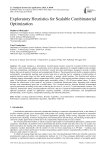
Exploratory Heuristics for Scalable Combinatorial Optimization
Статья научная
This paper introduces a deterministic insertion-based heuristic named the Localized Selective Insertion Heuristic, which incorporates adaptive mechanisms such as dynamic adjustment of evaluated neighbors and systematic seed route initialization, contributing to the heuristic's novelty and robust performance, designed to provide a reliable balance between the quality of solutions and computational efficiency. The proposed heuristic builds a complete solution incrementally, systematically inserting each unvisited node into an evolving tour by evaluating a limited number of potential insertion points based on their spatial proximity to already visited locations. This localized and selective evaluation strategy substantially reduces computational effort, typically allowing large problem instances to be solved in under 150 milliseconds, with achieved solution quality consistently within 2–14% of known optimal values. To clearly illustrate the effectiveness of this trade-off, we propose a Normalized Performance Index, integrating both solution accuracy and computational speed into a unified metric. The Localized Selective Insertion Heuristic demonstrated superior performance according to this index, achieving the best score in 16 out of 17 tested benchmark scenarios. The simplicity, deterministic nature, minimal parameter sensitivity, and ease of practical implementation make the proposed approach particularly suitable for applications requiring scalability, consistent performance, and straightforward reproducibility, such as logistics, transportation planning, and industrial automation.
Бесплатно
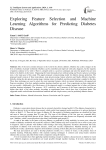
Exploring Feature Selection and Machine Learning Algorithms for Predicting Diabetes Disease
Статья научная
One of the most common diseases in the world is the chronic diabetes. Diabetes has a direct impact on the lives of millions of people worldwide. Diabetes can be controlled and improved with early diagnosis, but the majority of patients continue to live with it. There is a dispirit need to a system to anticipate and select the people who are most likely to be diabetes in the future. Diagnosing the future diseased person without taking any blood or glucose screening tests, is the main goal of this study. This paper proposed a deep-learning model for diabetes disease prediction. The proposed model consists of three main phases, data pre-processing, feature selection and finally different classifiers. Initially, during the data pre-processing stage, missing values are handled, and data normalization is applied to the data. Then, three techniques are used to select the most important features which are mutual information, chi-squared and Pearson correlation. After that, multiple machine learning classifiers are used. Four experiments are then conducted to test our models. Additionally, the effectiveness of the proposed model is evaluated against that of other well-known machine learning techniques. The accuracy, AUC, sensitivity, and F-measure of the linear regression classifier are higher than those of the other methods, according to experimental data, which show that it performs better. The suggested model worked better than traditional methods and had a high accuracy rate for predicting diabetic disease.
Бесплатно

